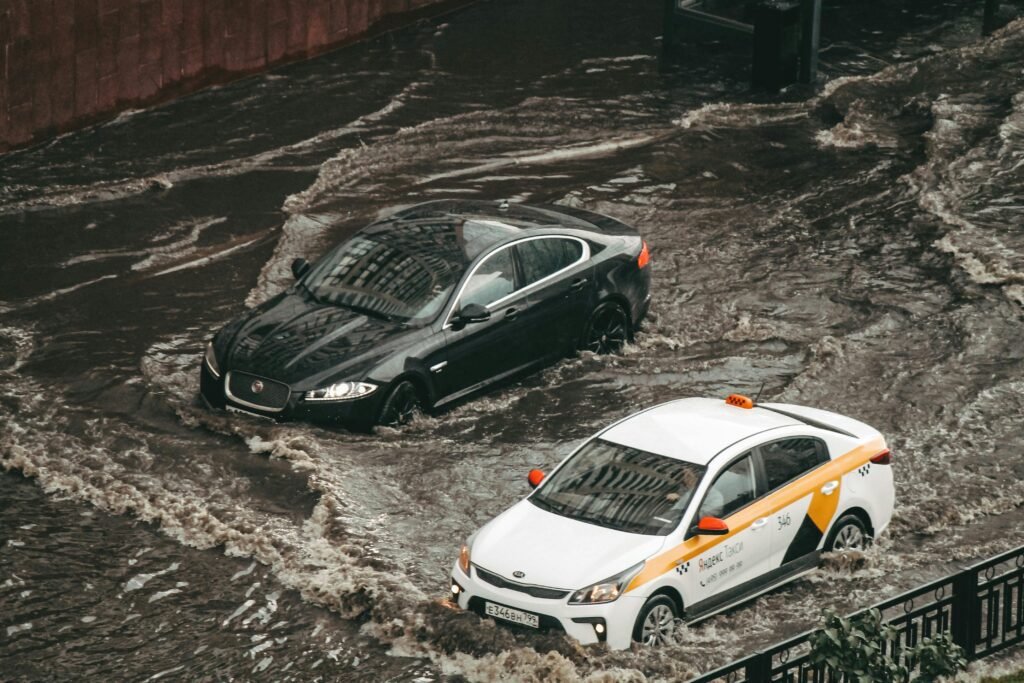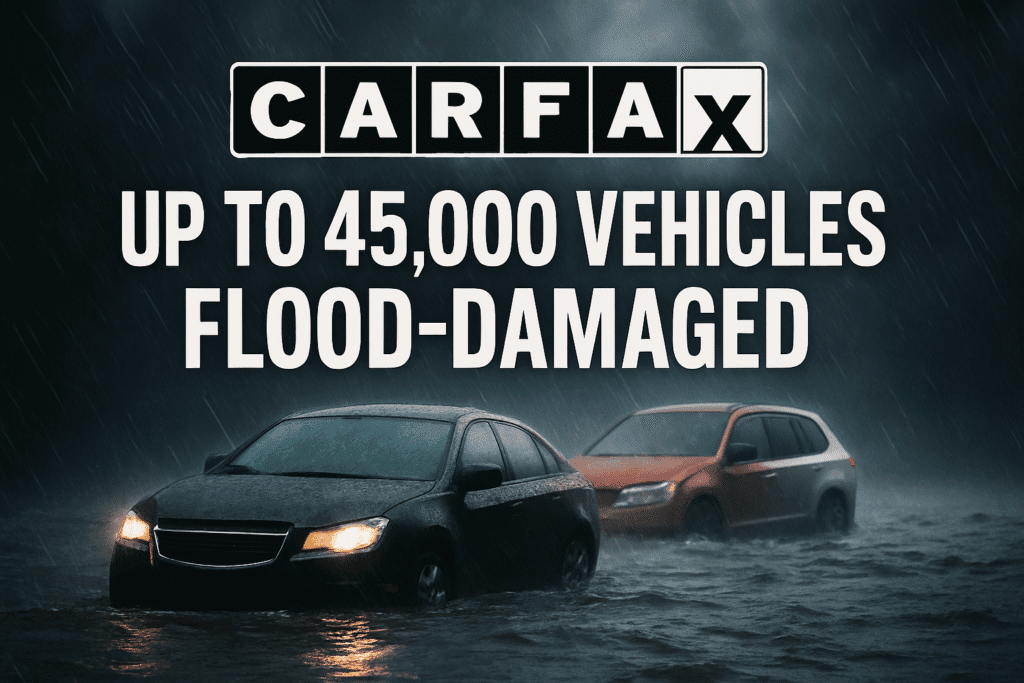How to avoid Flooded Cars for Sale?
As hurricane season intensifies in 2025, a hidden risk is flooding the used car market: an estimated 45,000 flood-damaged vehicles from mid-year storms. This adds to the 482,000 water-damaged cars already on U.S. roads (per CARFAX, August 6, 2025).
For car enthusiasts and budget-conscious buyers—especially those with bad credit seeking affordable options—this influx poses a significant challenge. In a market where used car prices remain elevated (despite a 5% drop in 2024), and monthly payments average $742 for new vehicles (J.D. Power, July 2025), unknowingly purchasing a flood-damaged car can lead to costly repairs and financial strain.
As someone passionate about empowering car lovers with smart financial decisions in the Automotive and Finance niche, this article equips you with strategies to identify, avoid, and navigate the risks of flood-damaged vehicles in 2025, ensuring you drive away in a reliable ride.
In this climate, it’s crucial to be cautious of flooded cars for sale as they can often be disguised as normal vehicles.
Being vigilant about flooded cars for sale can prevent major financial losses.
Understanding the risks associated with flooded cars for sale can save you from unexpected expenses.
It is essential to be aware of flooded cars for sale in order to make informed purchasing decisions and protect your investment.
The Growing Threat of Flood-Damaged Cars
Investing time in research can help you avoid the traps associated with purchasing flooded cars for sale.
Between April and July 2025, devastating storms and flash flooding swamped thousands of vehicles across Texas, Kentucky, West Virginia, and nearby states, according to CARFAX.
These 45,000 flood-damaged cars are expected to resurface in the used car market, often far from their storm-hit origins. States like Pennsylvania, Illinois, New Jersey, and California—where flooding isn’t top of mind—are seeing high concentrations of these vehicles.
Scammers clean and resell them to unsuspecting buyers. Faisal Hasan, CARFAX’s VP of Data Acquisition, warns, “These rehabbed cars may look showroom fresh, but they’re literally rotting from the inside out.”
As you navigate your options, always check for flooded cars for sale to avoid potential pitfalls.
This issue compounds an already challenging market. With used car demand holding strong, new car payments now consume 13–14% of household income (up from 9–10% in 2015). Bad-credit buyers are particularly vulnerable to flood-damaged vehicles sold at attractive prices.
Add regional disparities—Texas and Florida led with over 1 million vehicle sales each in 2024, while Midwestern states like Ohio sold less than half that—and it’s clear why vigilance is critical.

Why Flood-Damaged Cars Are a Risk
Flood damage can cause long-term issues that aren’t immediately visible:
- Electrical Failures: Water corrodes wiring, leading to malfunctions in lights, sensors, or infotainment systems, costing $1,000–$5,000 to repair.
- Mold and Corrosion: Damp interiors breed mold, posing health risks, while rust weakens critical components like brakes or the frame.
- Hidden Damage: About 50% of hurricane-damaged vehicles reenter the market, often without insurance claims or branded titles, per the Florida Automobile Dealers Association (FADA). Title-washing—where flood history is concealed—remains a problem in states with lax regulations.
For bad-credit buyers, who often face high interest rates (10–15% or more, per Experian Q3 2024), a flood-damaged car can turn a budget-friendly purchase into a financial nightmare.
Step 1: Use Tools to Check Vehicle History
Protect yourself by researching a car’s past before buying:
- CARFAX Flood Check®: Use CARFAX’s free Flood Check tool at carfax.com/flood to identify reported water damage. It’s not foolproof, as uninsured cars may slip through, but it’s a critical first step.
- Vehicle History Report: Obtain a CARFAX or AutoCheck report via platforms like Carfax Car Listings. Look for flood damage, salvage titles, or suspicious title transfers across states.
- VIN Verification: Check the Vehicle Identification Number (VIN) on the car (under the windshield or door jamb) against the report to ensure it hasn’t been altered.
Action: Run a Flood Check on any used car you’re considering, especially in states like Pennsylvania or Illinois, where flood-damaged vehicles often appear.

Step 2: Inspect for Telltale Signs of Flood Damage
Physical inspections are essential, as scammers can mask damage:
- Damp or Mismatched Carpets: Lift carpets under seats or in the trunk. Look for water stains, dampness, or upholstery that doesn’t match the car’s interior.
- Rust and Corrosion: Check for rust around doors, under the dashboard, on pedals, or in hood/trunk latches—unusual for newer cars.
- Musty Odor: Sniff for mold or mildew smells, even if masked by air fresheners. Open the glove compartment and trunk to check.
- Mud or Silt: Look for debris in unusual places, like under seats, in the glovebox, or high up in the engine bay.
- Brittle Wiring: Inspect wires under the dashboard for brittleness or corrosion, indicating water exposure.
- Moisture in Lights: Check for fog or water beads in headlights, taillights, or the instrument panel.
Pro Tip: Bring a flashlight to inspect hard-to-see areas. If you’re in a low-sales state like Ohio, consider hiring a mechanic for a pre-purchase inspection ($100–$200) to catch hidden damage.
Step 3: Navigate Financing and Dealerships
Bad-credit buyers must be extra cautious when financing used cars:
- Verify Dealer Reputation: Research dealers on Google or the Better Business Bureau, especially Buy Here, Pay Here (BHPH) lots, which may sell flood-damaged cars to subprime borrowers. Avoid “no credit, no problem” ads that hide predatory terms.
- Get Pre-Approved: Secure financing from a credit union or online lender (e.g., Capital One Auto Navigator) before visiting dealers. This sets a budget and reduces pressure to buy a risky car.
- Ask for Disclosures: Request a signed disclosure confirming the car hasn’t sustained flood damage. Per FADA, this protects you if the dealer misrepresents the vehicle’s history.
Action: Compare at least three lenders for rates (e.g., 8–15% for subprime) and prioritize credit unions in high-sales states like Texas for better terms.
Step 4: Choose Reliable, Low-Risk Vehicles
Focus on vehicles less likely to hide flood damage and more likely to hold value:
- Certified Pre-Owned (CPO): CPO cars from Toyota, Honda, or Mazda undergo rigorous inspections, reducing flood-damage risks. A 2023 Honda Civic CPO ($20,000) saves $5,000 vs. a new model.
- Low-Depreciation Models: Opt for Toyota Corolla, Subaru Forester, or Honda CR-V, which retain 70–80% of value after three years (per iSeeCars). This protects bad-credit buyers from negative equity.
- Avoid Flood-Prone Brands: Cars from brands with complex electronics (e.g., luxury BMWs) are harder to inspect for water damage. Stick to simpler, reliable models.
Regional Tip: In high-inventory states like Florida, browse CPO programs at major dealers or online platforms like Carvana for vetted used cars.
Step 5: Protect Your Investment
Safeguard your purchase to avoid surprises:
- Gap Insurance: For bad-credit buyers with high-rate loans (10–15%), gap insurance ($500–$800) covers the loan balance if a flood-damaged car is totaled.
- Extended Warranty: Consider a warranty ($1,000–$2,000) for used cars to cover electrical or mechanical failures from undetected flood damage.
- Regular Maintenance: Budget $50–$100/month for upkeep. Choose reliable models to minimize repair risks, and ask dealers for free maintenance packages (common with Hyundai).
Action: Use apps like Jerry to compare insurance quotes, targeting $150–$200/month for subprime borrowers. Confirm warranties cover water-related issues.
However, rising inventories (2.91 million units) and expected discounts later in 2025 (per Cox Automotive) offer bad-credit buyers leverage to find reliable used cars.
By using history reports, inspecting thoroughly, choosing vetted vehicles, securing smart financing, and protecting your investment, you can avoid the pitfalls of flood-damaged cars and drive with confidence.
With the National Oceanic and Atmospheric Administration predicting above-normal hurricane activity in 2025, the influx of flood-damaged cars may grow, especially in storm-prone states like Texas and Kentucky. However, rising inventories (2.91 million units) and expected discounts later in 2025 (per Cox Automotive) offer bad-credit buyers leverage to find reliable used cars. By using history reports, inspecting thoroughly, choosing vetted vehicles, securing smart financing, and protecting your investment, you can avoid the pitfalls of flood-damaged cars and drive with confidence.
Have you encountered a suspicious used car, or are you worried about flood damage? Share your experience in the comments, and I’ll provide a tailored tip to keep you on the right track! 🚗💸 #AutoFinance #CarBuying #MoneySmart
With the National Oceanic and Atmospheric Administration predicting above-normal hurricane activity in 2025, the influx of flood-damaged cars may grow, especially in storm-prone states like Texas and Kentucky.
Have you encountered a suspicious used car, or are you worried about flood damage? Share your experience in the comments, and I’ll provide a tailored tip to keep you on the right track!
#AutoFinance #CarBuying #MoneySmart
